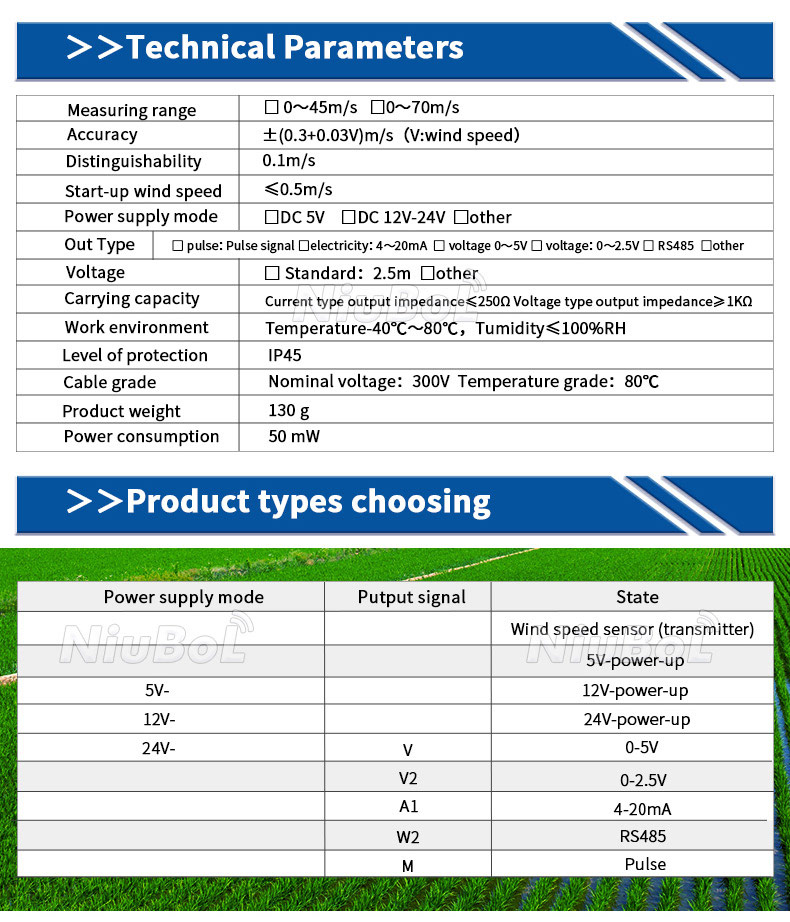

— Blogs —
—Products—
 Consumer hotline +8618073152920
Consumer hotline +8618073152920 WhatsApp:+8615367865107
Address:Room 102, District D, Houhu Industrial Park, Yuelu District, Changsha City, Hunan Province, China
Product knowledge
Time:2023-12-19 09:51:14 Popularity:612
A wind speed sensor, also known as an anemometer or wind gauge, is a device specifically designed to measure the speed of wind. It is commonly used in weather stations, environmental monitoring systems, and various applications that require wind speed data.
The wind speed sensor typically consists of one or more cups or propellers mounted on a shaft. When the wind blows, it causes the cups or propellers to rotate. The rotation is then converted into an electrical signal, which is proportional to the wind speed. This electrical signal can be processed and displayed as a numerical value or used in other calculations.
Modern wind speed sensors are often equipped with digital interfaces, such as RS-232 or RS-485, allowing for easy integration with data acquisition systems or computer networks. Additionally, some advanced wind speed sensors may include additional features like temperature compensation or built-in heating elements to prevent ice buildup in cold weather conditions.
Overall, the wind speed sensor plays a crucial role in accurately measuring and monitoring wind conditions for various practical applications, including weather forecasting, renewable energy systems, aviation, agriculture, and environmental research.
A wind speed sensor, also known as an anemometer, works based on the principle of measuring the rotational motion caused by the wind. There are different types of anemometers, but I'll explain the working principles of the cup and propeller anemometers, which are commonly used.
1. Cup Anemometer:
- A cup anemometer typically consists of three or four cups mounted on a horizontal shaft.
- When the wind blows, it causes the cups to rotate around the shaft.
- The rotational speed of the cups is directly proportional to the wind speed.
- Inside the anemometer, there is a mechanism that converts the rotation into an electrical signal.
- This electrical signal is then processed and calibrated to provide an accurate measurement of wind speed.

2. Propeller Anemometer:
- A propeller anemometer has a small propeller or rotor mounted on a vertical shaft.
- When the wind blows, it causes the propeller to spin.
- The rotational speed of the propeller is directly proportional to the wind speed.
- Like the cup anemometer, the rotation is converted into an electrical signal using a built-in mechanism.
- This electrical signal is then processed and calibrated to determine the wind speed accurately.
In both types of anemometers, the electrical signal generated by the rotation can be in the form of voltage pulses or frequency variations. These signals are typically fed into a data acquisition system or an instrument that converts them into numerical values representing wind speed. The anemometer may also have additional features like temperature compensation or heating elements to ensure accurate measurements in different weather conditions.

It's worth noting that there are other types of anemometers, such as hot-wire anemometers or sonic anemometers, which work on different principles. However, cup and propeller anemometers are widely used due to their simplicity, reliability, and cost-effectiveness.

wind speed sensors play an important role in the following fields and application scenarios:
1. Meteorological observation: Wind speed sensors are an essential part of weather stations and meteorological monitoring systems. They are used to measure and record wind speeds in the atmosphere, providing data support for weather forecasting, climate research and meteorology research.
2. Temperature control system: Wind speed sensors can be used for temperature control systems in buildings, offices or industrial facilities. By monitoring the wind speed indoors or outdoors, the system can automatically adjust the operation of the ventilation or air conditioning system to maintain comfortable environmental conditions.

3. Wind energy utilization: In wind farms, wind speed sensors are used to monitor and control the operation of wind turbines. They help determine the best speed and adjust blade angles to optimize wind energy conversion efficiency.
4. Aerospace: In aerospace engineering, wind speed sensors are used on aircraft, rockets and other spacecraft to measure wind speed and direction during flight. This is critical for navigation, flight safety and performance evaluation.
5. Environmental monitoring: Wind speed sensors also play an important role in environmental monitoring and research. They are used to measure air quality, atmospheric diffusion, pollutant transmission and other aspects to provide data support for environmental protection and management.
6. Flight simulation and aerodynamic research: In flight simulators and aerodynamic laboratories, wind speed sensors are used to measure airflow speed and direction around models or aircraft to help analyze aero.
Related recommendations
Sensors & Weather Stations Catalog
Agriculture Sensors and Weather Stations Catalog-NiuBoL.pdf
Weather Stations Catalog-NiuBoL.pdf
Related products
 Combined air temperature and relative humidity sensor
Combined air temperature and relative humidity sensor Soil Moisture Temperature sensor for irrigation
Soil Moisture Temperature sensor for irrigation Soil pH sensor RS485 soil Testing instrument soil ph meter for agriculture
Soil pH sensor RS485 soil Testing instrument soil ph meter for agriculture Wind Speed sensor Output Modbus/RS485/Analog/0-5V/4-20mA
Wind Speed sensor Output Modbus/RS485/Analog/0-5V/4-20mA Tipping bucket rain gauge for weather monitoring auto rainfall sensor RS485/Outdoor/stainless steel
Tipping bucket rain gauge for weather monitoring auto rainfall sensor RS485/Outdoor/stainless steel Pyranometer Solar Radiation Sensor 4-20mA/RS485
Pyranometer Solar Radiation Sensor 4-20mA/RS485
Screenshot, WhatsApp to identify the QR code
WhatsApp number:+8615367865107
(Click on WhatsApp to copy and add friends)